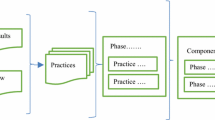Abstract
Alignment is one of the most important benefits that Enterprise Architecture (EA) could bring to organizations. However, it is still unclear what mechanism EA uses to help organizations achieve alignment. Related research is very scattered, making it difficult to accumulate relevant knowledge and experiences, and thus, the more successful EA application is hindered. To address this issue, the present research examines essential requirements of alignment and mechanisms with which underlying EA deliverable models impact organizations. By doing so, we proposed a conceptual framework explaining how EA modeling activities contribute to organizational alignment. We demonstrated the use of this framework with three use cases. The results show that EA could help organizations achieve alignment in quite different ways, and our proposed framework helped us examine and understand the mechanisms. We expect this research could establish an essential common understanding of how EA enables organizational alignment, thereby facilitating academia to move forward in this field.
Access this chapter
Tax calculation will be finalised at checkout
Purchases are for personal use only
Similar content being viewed by others
References
Guo, H., Li, J., Gao, S.: Understanding challenges of applying enterprise architecture in public sectors: a technology acceptance perspective. In: 2019 IEEE 23rd International Enterprise Distributed Object Computing Workshop (EDOCW). IEEE (2019)
Niemi, E., Enterprise architecture benefits: Perceptions from literature and practice. Tietotekniikan tutkimusinstituutin julkaisuja, vol. 18, pp. 1236–1615 (2008)
Tallon, P.P., Pinsonneault, A.: Competing perspectives on the link between strategic information technology alignment and organizational agility: insights from a mediation model. MIS Q. 35, 463–486 (2011)
Zhang, M., Chen, H., Luo, A.: A systematic review of business-IT alignment research with enterprise architecture. IEEE Access 6, 18933–18944 (2018)
Foorthuis, R., van Steenbergen, M., Brinkkemper, S., Bruls, W.A.G.: A theory building study of enterprise architecture practices and benefits. Inf. Syst. Front. 18(3), 541–564 (2015). https://doi.org/10.1007/s10796-014-9542-1
Merriam-Webster. Alignment (2021). https://www.merriam-webster.com/dictionary/alignment
Oxfordify. Alignment (2021). https://www.oxfordify.com/meaning/alignment
Maes, R., et al.: Redefining business-IT alignment through a unified framework. Universiteit Van Amsterdam/Cap Gemini White Paper (2000)
Gregor, S., Hart, D., Martin, N.: Enterprise architectures: enablers of business strategy and IS/IT alignment in government. Inf. Technol. People 20, 96–120 (2007)
Henderson, J.C., Venkatraman, H.: Strategic alignment: Leveraging information technology for transforming organizations. IBM Syst. J. 38(23), 472–484 (1999)
Luftman, J., Brier, T.: Achieving and sustaining business-IT alignment. Calif. Manage. Rev. 42(1), 109–122 (1999)
Luftman, J., Kempaiah, R.: An update on business-it alignment: “a line” has been drawn. MIS Q. Executive 6(3), 165–177 (2007)
ISO/IEC/IEEE, ISO/IEC/IEEE 42020:2019 (2019)
Wegner, P., Goldin, D.: Interaction as a framework for modeling. In: Goos, G., et al. (eds.) Conceptual Modeling. Lecture Notes in Computer Science, vol. 1565, pp. 243–257. Springer, Heidelberg (1999). https://doi.org/10.1007/3-540-48854-5_19
Krogstie, J., Sindre, G., Jørgensen, H.: Process models representing knowledge for action: a revised quality framework. Eur. J. Inf. Syst. 15(1), 91–102 (2006)
Lindland, O.I., Sindre, G., Solvberg, A.: Understanding quality in conceptual modeling. IEEE Softw. 11(2), 42 (1994)
Krogstie, J., Lindland, O.I., Sindre, G.: Defining quality aspects for conceptual models. In: Falkenberg, E.D., Hesse, W., Olivé, A. (eds.) Information System Concepts. IAICT, pp. 216–231. Springer, Boston, MA (1995). https://doi.org/10.1007/978-0-387-34870-4_22
Krogstie, J. and H.D. Jørgensen. Quality of interactive models. in International Conference on Conceptual Modeling. 2002. Springer.
Lapalme, J.: Three schools of thought on enterprise architecture. IT Prof. 14(6), 37–43 (2011)
Uludag, Ö., Nägele, S., Hauder, M.: Establishing architecture guidelines in large-scale agile development through institutional pressures: A single-case study (2019)
Avolution. Marshalling data (2021). https://www.avolutionsoftware.com/use-cases/data-privacy-security-enterprise-architecture/
Rozehnal, P., Novák, V.: The Core of Enterprise Architecture as a Management Tool: GDPR Implementation Case Study (2018)
Guo, H., et al.: Agile enterprise architecture by leveraging use cases. In Proceedings of the 16th International Conference on Evaluation of Novel Approaches to Software Engineering - MDI4SE. 2021, SciTePress
Nowakowski, E., Häusler, M., Breu, R.: Analysis of enterprise architecture tool support for industry 4.0 transformation planning. In: 2018 IEEE 22nd International Enterprise Distributed Object Computing Workshop (EDOCW). IEEE (2018)
Korhonen, J.J., et al.: Adaptive enterprise architecture for the future: towards a reconceptualization of EA. In: 2016 IEEE 18th Conference on Business Informatics (CBI). IEEE (2016)
Naranjo, D., Sánchez, M.E., Villalobos, J.: Evaluating the capabilities of enterprise architecture modeling tools for visual analysis. J. Object Technol. 14(1), 31-32 (2015)
Anthony, B., Petersen, S.A., Helfert, M.: Digital transformation of virtual enterprises for providing collaborative services in smart cities. In: Camarinha, L.M., Afsarmanesh, H., Ortiz, A. (eds.) PRO-VE 2020. IAICT, vol. 598, pp. 249–260. Springer, Cham (2020). https://doi.org/10.1007/978-3-030-62412-5_21
The Open Group, ARCHIMATE® 3.1 SPECIFICATION
Avolution. Avolution (2021). https://www.avolutionsoftware.com/
Guo, H., et al.: Boost the potential of EA: essential practices. In: Proceedings of the 23rd International Conference on Enterprise Information Systems, ICEIS 2021, vol. 2, p. 735–742
Acknowledgments
This research is financially supported by The European Research Consortium for Informatics and Mathematics (ERCIM) (https://www.ercim.eu/). This work has been partially supported by NFR 295920 IDUN.
Author information
Authors and Affiliations
Corresponding author
Editor information
Editors and Affiliations
Rights and permissions
Copyright information
© 2021 IFIP International Federation for Information Processing
About this paper
Cite this paper
Guo, H., Li, J., Gao, S., Smite, D. (2021). Understanding How Enterprise Architecture Contributes to Organizational Alignment. In: Dennehy, D., Griva, A., Pouloudi, N., Dwivedi, Y.K., Pappas, I., Mäntymäki, M. (eds) Responsible AI and Analytics for an Ethical and Inclusive Digitized Society. I3E 2021. Lecture Notes in Computer Science(), vol 12896. Springer, Cham. https://doi.org/10.1007/978-3-030-85447-8_33
Download citation
DOI: https://doi.org/10.1007/978-3-030-85447-8_33
Published:
Publisher Name: Springer, Cham
Print ISBN: 978-3-030-85446-1
Online ISBN: 978-3-030-85447-8
eBook Packages: Computer ScienceComputer Science (R0)





